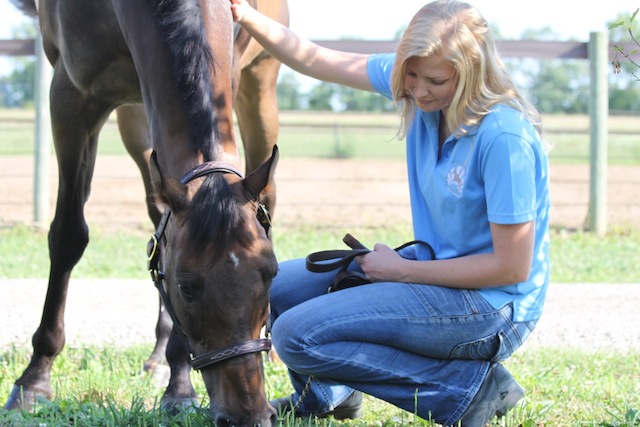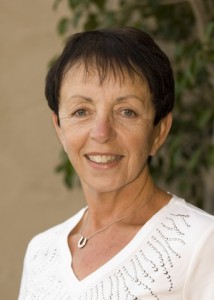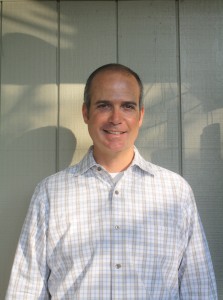
A retired racehorse at New Vocations enjoys a snack. Photo courtesy of New Vocations Racehorse Adoption
An army of volunteers and entrusted helpers has fanned out to visit Thoroughbred charities across the country, flipping the lips of all ex-racehorses in the care of myriad certified nonprofits, with the ultimate goal of ensuring the health and wellbeing of the noble racehorses turned over to individual charities.
The inspections have been carried out at the behest of the Thoroughbred Aftercare Alliance (TAA), a group formed two years ago, and comprised of leaders in all areas of the Thoroughbred racing and aftercare world.
Alliance Vice President Madeline Auerbach says the overall mission’s main goals are to ensure that horses in the care of certified nonprofit charities are in good health, and that their facilities in good repair, and for those charities that meet these standards, to grant accreditation and ultimately help to fund its operation.
“The goal of doing this is to make sure that every OTTB when he comes off the track will find a forever home, whether that’s a second career, or if they’re unable, a little pasture land to live in, and if they’re in a lot of pain, to have a plan to humanely euthanize them,” says Auerbach, who also chairs the California Retirement Management Account, a funding nonprofit, which has spearheaded successful partnerships among the state’s racing industry and aftercare organizations.
Expanding the concept, which was so successful in California, to cover a nation of horse charities, has required an exhaustive due diligence process that will ultimately lead to a plethora of charities that have been inspected and accredited by the TAA, she explains. And once accreditation is in place, those charities will reap the benefits of fundraising efforts by the TAA, she says.
“The TAA has a broad base of (funding) support,” Auerbach says. “We want to get funds from everybody and everything that makes money off of horses, from the tracks, the owners, breeders, hay deliverers, print media, all the way to the saddle makers and the gaming industry,” she says. “We’re trying to get a little bit from everybody.”
And those funds will be made available to accredited charities, she says.
Thus far, approximately 29 certified nonprofits, which own approximately 80 facilities housing horses, have applied for accreditation and agreed to inspection, says Mike Ziegler, current executive director of the NTRA Safety and Integrity Alliance and recent past executive director of the TAA. Ziegler is stepping down from the TAA after a year well spent, helping to oversee a painstaking process.
“The magnitude of this process of accreditation” has been far-reaching, he says. “It involves sending TAA inspectors to every one of the facilities operated by a (horse charity) to look at everything: They look at the basics, like food, water and shelter. Then we had people looking at the horse’s teeth and feet, fencing, and figuring out whether there’s enough land for the number of horses on it.”
Ziegler adds, “We want to eyeball the condition of every horse so that we can make sure they’re not in a bad way.”
In addition, the TAA also examined the business model of the nonprofit charity, studying its oversight and governing boards and ascertaining whether or not they’re in good standing with the IRS.
Though it has been a few years since the idea to found the TAA was first introduced by TAA Board president and Thoroughbred owner Jack Wolf, as the accreditation process makes its way toward the finish line, a victory could well be at hand—for the Thoroughbreds.

A Thoroughbred ex-racehorse enjoys a little exercise. Photo courtesy of New Vocations Racehorse Adoption
If all goes well, the TAA accreditation process will help ensure that horses are well cared for after their race careers end, and also make certain that funds donated to the charities that care for them are properly handled, Auerbach says.
“One of the biggest problems facing all charities is that when people give enormous sums of money” they want to be assured the money is going toward its intended purpose, Auerbach says. “The TAA wants to convince everyone in the industry that when they give their money to us, to be distributed among accredited nonprofits, that it will be utilized properly, effectively, and will go toward saving these great equine athletes.”




Everything that is being put in place will go a long way to protecting these horses from falling into the hands of unscrupulous people running a so-called rescue and getting donations but neglects and starves the horses in their care, then drops them at a auction to get rid of them. This is why so many of these horses have been found in this condition headed for slaughter. I hope what these caring folks have started spreads across the country to include all race tracks and owners helping to create a new beginning for all retired race horses instead the horses ending their life in the kill box.
Just want to note that these 3 fine organizations were fully accredited in July: Florida Thoroughbred Retirement and Adoptive Care, New Vocations, and Southern California Thoroughbred Rescue
I am so glad that there is now an inspection/certification process for the non-profits taking on the re-homing of ex-racehorses. I only hope that the results of the certification process can be accessed by those of us who donate to these organizations, or who may be considering donating to one or more of them.
As one who was involved in the inspection/certification process, I know that the findings of the inspections will on occasion not be exceptionally stellar. I only hope that those that do not “make the grade”, are dealt with fairly, for the horses’ sake. I also hope that minor deviations and non-conformances can be quickly corrected, and the facility can be certified once they have shown the corrections. I also hope that the accrediting body has a good and robust standard from which is used in the process.
Also, I’m assuming that the volunteers engaged in the inspections are properly trained so as to be thorough, fair and standardized so that the same criteria is used at each and every facility.
I applaud the industry taking a stance and engaging all players in the horse business.